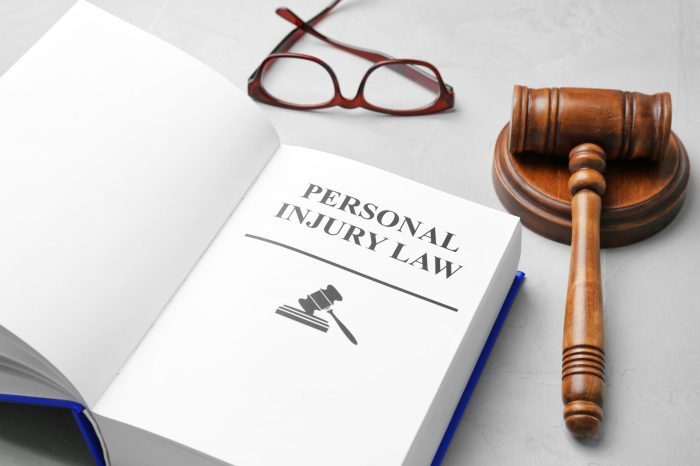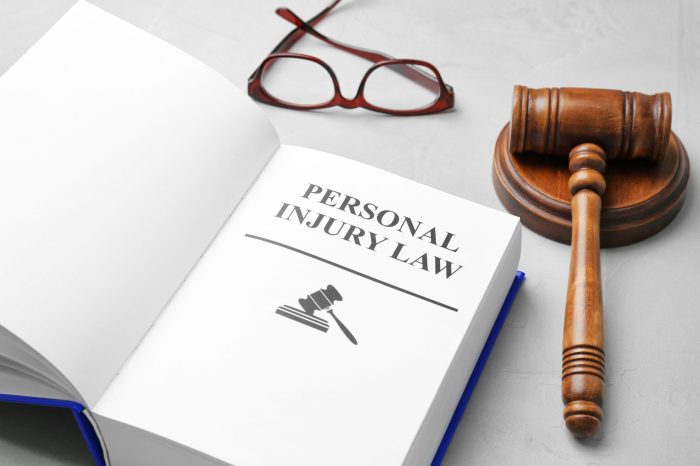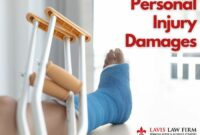Personal injury lawyer responsibilities encompass a wide range of tasks, from client consultations to courtroom battles. These legal professionals play a crucial role in helping individuals who have suffered injuries due to negligence or wrongdoing. Their responsibilities extend beyond legal expertise, encompassing compassion, communication, and a strong commitment to achieving justice for their clients.
From the initial intake process, where lawyers gather crucial information and evidence, to the meticulous preparation for potential litigation, personal injury lawyers navigate complex legal landscapes to secure the best possible outcomes for their clients. This article explores the multifaceted responsibilities of personal injury lawyers, shedding light on the essential skills and ethical considerations that underpin their practice.
Client Consultation and Intake
The initial client consultation is a crucial step in a personal injury case. It allows the lawyer to gather information about the client’s situation, assess the potential for a successful claim, and determine if they are the right fit to represent the client.
Initial Steps
The first step in a client consultation is typically a phone call or email exchange to schedule a meeting. During this initial contact, the lawyer should gather basic information about the client’s case, such as the nature of the injury, the date and location of the incident, and the identity of the potential defendant.
This information helps the lawyer determine if the case falls within their area of expertise and if they have the resources to handle it.
Key Questions, Personal injury lawyer responsibilities
During the intake process, a personal injury lawyer should ask a series of questions to gather comprehensive information about the client’s case. These questions should cover various aspects of the incident, the client’s injuries, and their medical treatment.
- Details of the Incident: The lawyer should inquire about the specific details of the incident, including the date, time, and location. They should also ask about the circumstances surrounding the incident, such as the weather conditions, any witnesses present, and any contributing factors.
- Nature of the Injuries: The lawyer should ask about the client’s injuries, including the specific types of injuries, the severity of the injuries, and any long-term effects. They should also inquire about any medical treatment the client has received, including the names of doctors, hospitals, and medications.
- Financial Impact: The lawyer should ask about the financial impact of the client’s injuries, including lost wages, medical expenses, and other out-of-pocket costs. They should also inquire about any insurance policies the client has, including health insurance, auto insurance, and homeowner’s insurance.
- Previous Legal History: The lawyer should ask about the client’s previous legal history, including any prior personal injury claims or lawsuits. They should also inquire about any criminal convictions or other legal matters that could be relevant to the case.
Essential Documentation
It is essential for a personal injury lawyer to collect relevant documentation from their clients. This documentation helps to build a strong case and support the client’s claims.
- Medical Records: The lawyer should obtain all medical records related to the client’s injuries, including doctor’s notes, hospital records, and diagnostic tests. These records provide evidence of the client’s injuries, treatment, and prognosis.
- Police Report: If the incident involved a car accident, slip and fall, or other incident reported to the police, the lawyer should obtain a copy of the police report. This report provides an official account of the incident and can be helpful in establishing liability.
- Insurance Policies: The lawyer should obtain copies of the client’s insurance policies, including health insurance, auto insurance, and homeowner’s insurance. This information helps the lawyer understand the client’s coverage and potential benefits.
- Pay Stubs: The lawyer should obtain copies of the client’s pay stubs to document their lost wages. This evidence can be used to support the client’s claim for lost income.
- Bills and Receipts: The lawyer should obtain copies of bills and receipts related to the client’s medical expenses, lost wages, and other out-of-pocket costs. This documentation provides evidence of the client’s financial losses.
Investigation and Evidence Gathering: Personal Injury Lawyer Responsibilities
Thorough investigation and meticulous evidence gathering are crucial in personal injury cases. This process involves gathering information to establish liability, damages, and the strength of the client’s claim.
Types of Evidence
The types of evidence a lawyer should gather in a personal injury case can be broadly categorized into three main groups:
- Witness Statements: Witness statements provide firsthand accounts of the incident and can be invaluable in establishing the sequence of events, the actions of the parties involved, and any contributing factors. These statements should be obtained promptly and accurately to preserve the details while memories are fresh.
- Medical Records: Medical records document the extent of the client’s injuries and treatment, including diagnoses, prognoses, and the cost of medical care. These records are essential for demonstrating the severity of the injuries and the impact on the client’s life.
- Accident Reports: Accident reports, such as police reports or incident reports, provide an official record of the incident, including details about the location, time, and circumstances of the accident. They often contain valuable information about the parties involved, any witnesses present, and the contributing factors to the accident.
Methods of Investigation
The investigation process involves a variety of methods to gather evidence and establish the facts of the case. These methods include:
- Interviews: Interviews are conducted with the client, witnesses, and other relevant individuals to obtain firsthand accounts of the incident. This involves asking open-ended questions, taking detailed notes, and documenting the interview process.
- Site Inspections: Site inspections allow the lawyer to observe the location of the accident and gather evidence such as photographs, measurements, and other relevant details. This helps reconstruct the events leading to the accident and identify potential contributing factors.
- Document Review: Reviewing documents such as medical records, accident reports, insurance policies, and other relevant paperwork can provide valuable information about the incident, the parties involved, and the extent of the injuries.
- Expert Witnesses: In some cases, expert witnesses such as medical professionals, engineers, or accident reconstruction specialists may be needed to provide expert opinions and analysis. These experts can offer valuable insights and support the client’s claims.
Technology in Investigation
Technology plays an increasingly significant role in personal injury investigations, enabling lawyers to gather and analyze evidence more efficiently and effectively. Some examples of how technology can enhance the investigation process include:
- Digital Evidence: Digital evidence, such as photographs, videos, text messages, and social media posts, can provide valuable insights into the incident and the parties involved. Lawyers can use software tools to analyze and preserve this evidence.
- Online Research: Online research tools can be used to gather information about the incident, the parties involved, and relevant laws and regulations. This can help lawyers develop a comprehensive understanding of the case and identify potential legal arguments.
- Mapping Software: Mapping software can be used to reconstruct the accident scene, identify potential hazards, and analyze the movement of vehicles or pedestrians. This can be particularly helpful in cases involving traffic accidents.
Legal Research and Case Evaluation
A personal injury lawyer must thoroughly understand the legal landscape surrounding their client’s case. This involves conducting legal research to identify applicable laws and precedents and evaluating the strength of the case based on the gathered evidence and potential legal arguments.
Identifying Applicable Laws and Precedents
Legal research is a crucial step in determining the legal basis of a personal injury claim. This involves identifying and analyzing relevant statutes, case law, and regulations that govern the specific legal issues in the case.
- Statutes:These are laws enacted by legislative bodies, such as state legislatures or Congress, that define legal rights and obligations. For example, a personal injury case might involve statutes related to negligence, product liability, or medical malpractice.
- Case Law:Case law, or precedent, refers to decisions made by courts in previous cases that are similar to the current case. These decisions can provide guidance on how the law should be applied in a particular situation. For instance, a lawyer might research previous cases involving similar types of injuries, negligence claims, or settlements to understand how courts have ruled in comparable circumstances.
- Regulations:Regulations are rules and guidelines issued by government agencies to implement statutes. These regulations can be relevant to personal injury cases, particularly those involving specific industries or activities. For example, regulations related to workplace safety or product standards might be applicable.
Evaluating the Strength of a Case
Once the applicable laws and precedents have been identified, the lawyer must evaluate the strength of the case based on the facts and evidence. This involves assessing the likelihood of success in court and determining the potential value of the claim.
- Evidence:This includes any documents, photographs, witness statements, medical records, and other materials that support the client’s claims. A strong case will have substantial evidence to support the client’s version of events.
- Damages:Damages are the financial losses suffered by the client as a result of the injury. This can include medical expenses, lost wages, pain and suffering, and other types of harm. The lawyer must assess the extent of the client’s damages to determine the potential value of the claim.
- Liability:Liability refers to the legal responsibility for causing the injury. The lawyer must determine if the defendant can be held legally liable for the client’s injuries.
Assessing Potential Legal Arguments and Defenses
A personal injury lawyer must consider potential legal arguments and defenses that could be raised by the opposing party. This involves anticipating the defendant’s strategy and developing counterarguments.
- Potential Legal Arguments:This includes identifying any legal theories or arguments that could be used to support the client’s claim. For example, the lawyer might argue that the defendant was negligent, breached a contract, or violated a product liability statute.
- Potential Defenses:The lawyer must anticipate the defendant’s defenses, such as contributory negligence, assumption of risk, or the statute of limitations. The lawyer needs to develop strategies to counter these defenses and strengthen the client’s case.
Negotiation and Settlement
Negotiating a fair settlement is a crucial part of the personal injury process. Your lawyer will work tirelessly to ensure you receive the compensation you deserve for your injuries and losses. This section will explore the negotiation process and the role your lawyer plays in advocating for your best interests.
Negotiation Process with Insurance Companies and Opposing Counsel
Negotiating a settlement involves communicating with insurance companies and opposing counsel to reach a mutually agreeable agreement. The goal is to settle your claim outside of court, which can save time, money, and stress.
Negotiation with Insurance Companies
Insurance companies often have their own set of procedures and tactics for handling claims. They are generally motivated to minimize payouts, so your lawyer will need to be assertive and strategic in their approach.
- Gathering Evidence:Your lawyer will gather all relevant documentation, including medical records, police reports, and photos of the accident scene, to support your claim.
- Evaluating the Claim:The lawyer will carefully assess the value of your claim based on the severity of your injuries, medical expenses, lost wages, and other damages.
- Initial Demand:Your lawyer will submit a demand letter to the insurance company outlining the damages you seek. This letter will be based on a thorough analysis of your case and the applicable law.
- Negotiations:Your lawyer will negotiate with the insurance company’s adjuster, presenting a compelling case for a fair settlement. They will use the evidence gathered to support your claim and refute any arguments made by the insurance company.
- Counteroffers:Insurance companies will often make counteroffers, which your lawyer will evaluate and respond to. They will continue to negotiate until a mutually agreeable settlement is reached.
Negotiation with Opposing Counsel
In some cases, you may be dealing with opposing counsel representing the other party involved in the accident. This can add another layer of complexity to the negotiation process.
- Discovery:The opposing counsel may request documents and information through a process called discovery. Your lawyer will ensure that you provide the necessary information and will also request information from the opposing party to build a strong case.
- Mediation:Mediation is a process where a neutral third party facilitates negotiations between the parties. Your lawyer will work with you to prepare for mediation and advocate for a fair settlement.
- Settlement Agreement:If a settlement is reached, your lawyer will draft a formal settlement agreement that Artikels the terms of the agreement and protects your rights.
Role of a Lawyer in Advocating for a Fair Settlement
Your lawyer’s role is crucial in ensuring you receive a fair settlement. They will:
- Protect your rights:Your lawyer will ensure that your rights are protected throughout the negotiation process.
- Negotiate effectively:They will use their knowledge and experience to negotiate a favorable settlement for you.
- Evaluate settlement offers:Your lawyer will carefully evaluate any settlement offers and advise you on whether they are fair and reasonable.
- Advise you on legal options:Your lawyer will provide you with legal advice and guidance throughout the process, explaining your options and helping you make informed decisions.
- Handle all communications:Your lawyer will handle all communications with insurance companies and opposing counsel, protecting you from the stress and hassle of dealing with them directly.
Common Negotiation Tactics and Strategies
Negotiating a settlement requires skill and strategy. Your lawyer will use various tactics and strategies to achieve the best possible outcome for you.
Tactics
- Building rapport:Establishing a positive relationship with the other party can help create a more cooperative negotiation environment.
- Active listening:Understanding the other party’s perspective and concerns can help you identify areas of common ground and potential compromises.
- Framing the issue:Presenting the issue in a way that highlights your client’s needs and priorities can influence the negotiation.
- Using deadlines:Establishing deadlines for settlement can create a sense of urgency and encourage the other party to reach an agreement.
- Walking away:Being willing to walk away from a negotiation if the terms are not acceptable can demonstrate your resolve and potentially lead to a better offer.
Strategies
- BATNA (Best Alternative to a Negotiated Agreement):Understanding your BATNA, or the best alternative to a negotiated agreement, can help you determine your bottom line in negotiations.
- ZOPA (Zone of Possible Agreement):Identifying the ZOPA, or the range of possible outcomes that both parties find acceptable, can help you focus your negotiations on a realistic settlement.
- Anchoring:Setting an initial anchor point, such as a demand letter, can influence the negotiation and potentially lead to a more favorable outcome.
- Concessions:Being willing to make concessions, while still advocating for your client’s best interests, can help move the negotiation forward.
Litigation and Trial Preparation

If a settlement cannot be reached, a personal injury case may proceed to litigation. This involves filing a lawsuit, participating in pre-trial discovery, and ultimately, going to trial.
Preparing for Trial
Trial preparation is a crucial stage, involving a meticulous approach to ensure a strong case presentation. The lawyer must carefully gather and organize all evidence, prepare witnesses for testimony, and develop a comprehensive trial strategy.
- Organizing Evidence:The lawyer meticulously reviews all evidence collected during the investigation phase, including medical records, police reports, witness statements, and photographs. This evidence is then categorized and organized for easy access during trial.
- Witness Preparation:The lawyer prepares witnesses for their testimony, ensuring they understand the legal process and the importance of providing clear and concise answers. They also practice with witnesses to anticipate potential questions and ensure they are comfortable and confident during their testimony.
- Developing Trial Strategy:The lawyer develops a detailed trial strategy, outlining the key arguments, evidence to be presented, and the overall approach to the case. This strategy considers the strengths and weaknesses of the case, the opposing party’s arguments, and the likely arguments the jury may find persuasive.
Jury Selection
The jury selection process is critical in a personal injury trial. The lawyer aims to select jurors who are fair, impartial, and likely to be sympathetic to the client’s case.
- Questioning Potential Jurors:During jury selection, the lawyer questions potential jurors to assess their backgrounds, experiences, and potential biases. This process helps determine if any jurors may be prejudiced against the client or the type of injury involved.
- Using Peremptory Challenges:Lawyers have a limited number of peremptory challenges, which allow them to dismiss potential jurors without providing a reason. This strategy is often used to remove jurors who may be perceived as unfavorable to the client’s case.
- Strategic Jury Selection:Lawyers use their knowledge of the case and the potential jurors’ backgrounds to make strategic decisions about which jurors to keep and which to dismiss. The goal is to create a jury that is receptive to the client’s arguments and likely to reach a favorable verdict.
Presenting Evidence
The lawyer plays a pivotal role in presenting evidence at trial. This involves strategically introducing evidence to support the client’s claims and effectively communicating the facts to the jury.
- Direct Examination:During direct examination, the lawyer questions their own witnesses to elicit testimony that supports the client’s case. The goal is to present a clear and concise narrative that persuades the jury of the client’s claims.
- Cross-Examination:The lawyer cross-examines opposing witnesses to challenge their testimony, highlight inconsistencies, and undermine their credibility. This can be a critical step in weakening the opposing party’s case and bolstering the client’s arguments.
- Introducing Exhibits:The lawyer presents physical evidence, such as medical records, photographs, and videos, to support the client’s case. These exhibits can be powerful tools for visually demonstrating the impact of the injury and the extent of the client’s damages.
Examining Witnesses
Effective witness examination is crucial for presenting a strong case at trial. The lawyer must be skilled at asking questions that elicit clear and concise answers while maintaining control of the examination.
- Leading Questions:During direct examination, the lawyer can use leading questions to guide the witness’s testimony and highlight key points. However, leading questions are not permitted during cross-examination, as they can influence the witness’s responses.
- Open-Ended Questions:Open-ended questions encourage the witness to provide detailed answers and can be effective in eliciting unexpected information. These questions are particularly useful during cross-examination, where the lawyer aims to expose inconsistencies or weaknesses in the witness’s testimony.
- Objections:The lawyer must be prepared to object to improper questions asked by the opposing counsel. Objections can help ensure a fair trial and prevent the jury from hearing irrelevant or inadmissible evidence.
Trial Strategies
Effective trial strategies are essential for maximizing the client’s chances of success. Lawyers employ a variety of tactics to persuade the jury and achieve a favorable outcome.
- Opening Statement:The opening statement provides the lawyer with an opportunity to introduce the case to the jury and Artikel the key arguments. This statement should be clear, concise, and engaging, setting the stage for the evidence to be presented.
- Closing Arguments:The closing arguments allow the lawyer to summarize the evidence, reiterate the key arguments, and persuade the jury to reach a verdict in favor of the client. This is the final opportunity to make a strong impression on the jury and highlight the importance of the case.
- Using Visual Aids:Visual aids, such as photographs, charts, and diagrams, can be effective tools for illustrating key points and making complex information more accessible to the jury. They can help the jury understand the facts of the case and the impact of the injury on the client.
Client Communication and Advocacy
Effective communication is the cornerstone of a successful attorney-client relationship. Building trust and maintaining transparency are paramount in ensuring a client feels heard, understood, and confident in their legal representation.
Keeping Clients Informed
Regular communication is crucial for fostering a strong attorney-client relationship. Clients need to be kept informed about the progress of their case, the legal options available to them, and any significant developments.
- Regular Updates:Attorneys should provide regular updates to clients, even if there is no major news. This can be done through phone calls, emails, or even text messages. This ensures clients feel informed and valued.
- Case Progress Updates:Clients should be informed of any significant developments in their case, such as the filing of court documents, responses from opposing counsel, or scheduling of hearings. This helps clients understand the timeline and steps involved in their case.
- Legal Options:Attorneys should explain the legal options available to their clients, including the potential risks and benefits of each option. This empowers clients to make informed decisions about their case.
- Clear and Concise Communication:Attorneys should use clear and concise language when communicating with clients, avoiding legal jargon that may be confusing. They should also be patient and answer any questions clients may have.
Ethical Considerations and Professional Responsibility
Personal injury lawyers, like all legal professionals, are bound by a strict code of ethics that governs their conduct and ensures they uphold the integrity of the legal system. This code emphasizes principles such as confidentiality, honesty, and fairness, all of which are essential to maintaining public trust in the legal profession.
Confidentiality and Client Privilege
Confidentiality is paramount in the attorney-client relationship. Clients must be able to trust their lawyers with sensitive information without fear of disclosure. This trust is crucial for effective representation, as clients need to feel comfortable sharing all relevant details of their case, even if they are embarrassing or potentially damaging.
- The attorney-client privilege protects communications between lawyers and their clients from disclosure in legal proceedings, except in specific circumstances.
- This privilege is essential for maintaining open and honest communication between clients and their lawyers, enabling them to develop the strongest possible case.
- Personal injury lawyers must be mindful of the limits of this privilege and ensure they do not disclose confidential information without the client’s consent.
Conflicts of Interest
A conflict of interest arises when a lawyer’s personal or professional interests could potentially compromise their ability to act in the best interests of their client. These conflicts can arise in various situations, and lawyers must be vigilant in identifying and resolving them.
- For example, if a lawyer is representing multiple clients in a case with conflicting interests, they may need to withdraw from representing one or both clients to avoid compromising their ability to act impartially.
- Personal injury lawyers must also be aware of conflicts that may arise from their personal relationships or financial interests.
- They must disclose any potential conflicts to their clients and obtain their informed consent before proceeding with the representation.
Maintaining Professional Standards
Personal injury lawyers are expected to adhere to the highest professional standards, including honesty, integrity, and competence. This includes:
- Being truthful and accurate in all dealings with clients, opposing counsel, and the court.
- Avoiding any conduct that could bring disrepute to the legal profession.
- Keeping abreast of changes in the law and relevant legal developments.
- Maintaining confidentiality and protecting client information.
- Treating all parties with respect and courtesy.
Ethical Dilemmas in Personal Injury Law
Personal injury lawyers often face ethical dilemmas that require careful consideration and judgment. Some common dilemmas include:
- Balancing the client’s desire for a large settlement with the lawyer’s ethical obligation to be honest and fair.
- Deciding whether to pursue a case that has a weak legal basis but could potentially result in a large settlement.
- Dealing with clients who are dishonest or have a history of exaggerating their injuries.
- Navigating the ethical considerations of using social media in a personal injury case.
Final Thoughts
Navigating the complexities of personal injury law requires a unique blend of legal acumen, strategic thinking, and unwavering dedication to client advocacy. By understanding the responsibilities of personal injury lawyers, individuals seeking legal representation can make informed decisions and confidently entrust their cases to qualified professionals.
Remember, choosing the right lawyer is crucial in ensuring that your rights are protected and that you receive the compensation you deserve.
Q&A
What are the typical fees for personal injury lawyers?
Personal injury lawyers often work on a contingency fee basis, meaning they only get paid if they secure a settlement or win a judgment for their client. The fee is typically a percentage of the recovery, ranging from 33% to 40%.
What are the common ethical dilemmas faced by personal injury lawyers?
Ethical dilemmas can arise in areas such as client confidentiality, conflicts of interest, and the balance between zealous advocacy and ethical conduct. For example, a lawyer may face a conflict of interest if they represent multiple clients with conflicting interests in the same case.
How can I find a reputable personal injury lawyer?
You can find reputable lawyers through referrals from friends, family, or other professionals. You can also search online directories or contact your state bar association for lawyer referral services.




